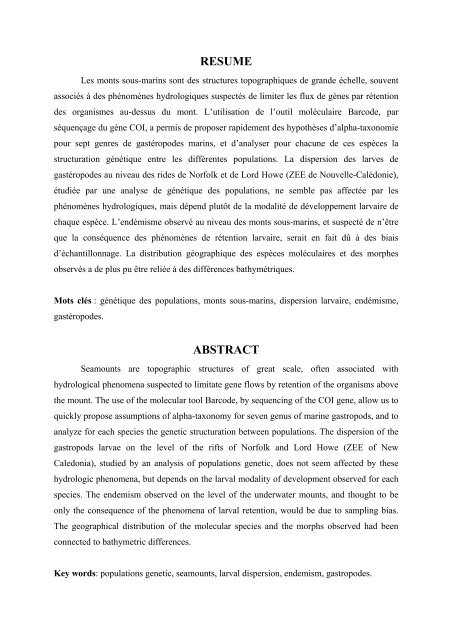Stage de Master 2 au Muséum National d - MAG' SITE
Stage de Master 2 au Muséum National d - MAG' SITE
Stage de Master 2 au Muséum National d - MAG' SITE
Create successful ePaper yourself
Turn your PDF publications into a flip-book with our unique Google optimized e-Paper software.
RESUME<br />
Les monts sous-marins sont <strong>de</strong>s structures topographiques <strong>de</strong> gran<strong>de</strong> échelle, souvent<br />
associés à <strong>de</strong>s phénomènes hydrologiques suspectés <strong>de</strong> limiter les flux <strong>de</strong> gènes par rétention<br />
<strong>de</strong>s organismes <strong>au</strong>-<strong>de</strong>ssus du mont. L’utilisation <strong>de</strong> l’outil moléculaire Barco<strong>de</strong>, par<br />
séquençage du gène COI, a permis <strong>de</strong> proposer rapi<strong>de</strong>ment <strong>de</strong>s hypothèses d’alpha-taxonomie<br />
pour sept genres <strong>de</strong> gastéropo<strong>de</strong>s marins, et d’analyser pour chacune <strong>de</strong> ces espèces la<br />
structuration génétique entre les différentes populations. La dispersion <strong>de</strong>s larves <strong>de</strong><br />
gastéropo<strong>de</strong>s <strong>au</strong> nive<strong>au</strong> <strong>de</strong>s ri<strong>de</strong>s <strong>de</strong> Norfolk et <strong>de</strong> Lord Howe (ZEE <strong>de</strong> Nouvelle-Calédonie),<br />
étudiée par une analyse <strong>de</strong> génétique <strong>de</strong>s populations, ne semble pas affectée par les<br />
phénomènes hydrologiques, mais dépend plutôt <strong>de</strong> la modalité <strong>de</strong> développement larvaire <strong>de</strong><br />
chaque espèce. L’endémisme observé <strong>au</strong> nive<strong>au</strong> <strong>de</strong>s monts sous-marins, et suspecté <strong>de</strong> n’être<br />
que la conséquence <strong>de</strong>s phénomènes <strong>de</strong> rétention larvaire, serait en fait dû à <strong>de</strong>s biais<br />
d’échantillonnage. La distribution géographique <strong>de</strong>s espèces moléculaires et <strong>de</strong>s morphes<br />
observés a <strong>de</strong> plus pu être reliée à <strong>de</strong>s différences bathymétriques.<br />
Mots clés : génétique <strong>de</strong>s populations, monts sous-marins, dispersion larvaire, endémisme,<br />
gastéropo<strong>de</strong>s.<br />
ABSTRACT<br />
Seamounts are topographic structures of great scale, often associated with<br />
hydrological phenomena suspected to limitate gene flows by retention of the organisms above<br />
the mount. The use of the molecular tool Barco<strong>de</strong>, by sequencing of the COI gene, allow us to<br />
quickly propose assumptions of alpha-taxonomy for seven genus of marine gastropods, and to<br />
analyze for each species the genetic structuration between populations. The dispersion of the<br />
gastropods larvae on the level of the rifts of Norfolk and Lord Howe (ZEE of New<br />
Caledonia), studied by an analysis of populations genetic, does not seem affected by these<br />
hydrologic phenomena, but <strong>de</strong>pends on the larval modality of <strong>de</strong>velopment observed for each<br />
species. The en<strong>de</strong>mism observed on the level of the un<strong>de</strong>rwater mounts, and thought to be<br />
only the consequence of the phenomena of larval retention, would be due to sampling bias.<br />
The geographical distribution of the molecular species and the morphs observed had been<br />
connected to bathymetric differences.<br />
Key words: populations genetic, seamounts, larval dispersion, en<strong>de</strong>mism, gastropo<strong>de</strong>s.


